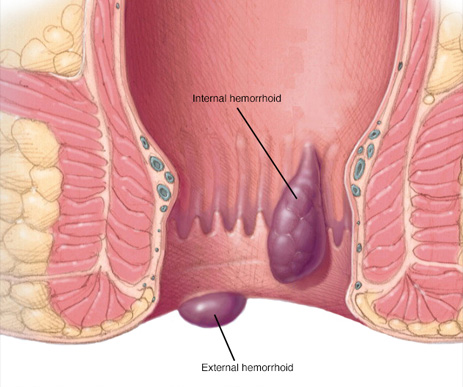
A precise definition of hemorrhoids does not exist, but they can be described as masses or clumps ("cushions") of tissue within the anal canal that contain blood vessels and the surrounding, supporting tissue made up of muscle and elastic fibers. The anal canal is the last four centimeters through which stool passes as it goes from the rectum to the outside world. The anus is the opening of the anal canal to the outside world.
Although most people think hemorrhoids are abnormal, they are present in everyone. It is only when the hemorrhoidal cushions enlarge that hemorrhoids can cause problems and be considered abnormal or a disease.
Prevalence of hemorrhoids
Although hemorrhoids occur in everyone, they become large and cause problems in only 4% of the general population. Hemorrhoids that cause problems are found equally in men and women, and their prevalence peaks between 45 and 65 years of age.
Anatomy of hemorrhoids
The arteries supplying blood to the anal canal descend into the canal from the rectum above and form a rich network of arteries that communicate with each other around the anal canal. Because of this rich network of arteries, hemorrhoidal blood vessels have a ready supply of arterial blood. This explains why bleeding from hemorrhoids is bright red (arterial blood) rather than dark red (venous blood), and why bleeding from hemorrhoids occasionally can be severe. The blood vessels that supply the hemorrhoidal vessels pass through the supporting tissue of the hemorrhoidal cushions.
The anal veins drain blood away from the anal canal and the hemorrhoids. These veins drain in two directions. The first direction is upwards into the rectum, and the second is downwards beneath the skin surrounding the anus. The dentate line is a line within the anal canal that denotes the transition from anal skin (anoderm) to the lining of the rectum.
Formation of hemorrhoids
If the hemorrhoid originates at the top (rectal side) of the anal canal, it is referred to as an internal hemorrhoid. If it originates at the lower end of the anal canal near the anus, it is referred to as an external hemorrhoid. Technically, the differentiation between internal and external hemorrhoids is made on the basis of whether the hemorrhoid originates above or below the dentate line (internal and external, respectively).
As discussed previously, hemorrhoidal cushions in the upper anal canal are made up of blood vessels and their supporting tissues. There usually are three major hemorrhoidal cushions oriented right posterior, right anterior, and left lateral. During the formation of enlarged internal hemorrhoids, the vessels of the anal cushions swell and the supporting tissues increase in size.
The bulging mass of tissue and blood vessels protrudes into the anal canal where it can cause problems. Unlike with internal hemorrhoids, it is not clear how external hemorrhoids form.